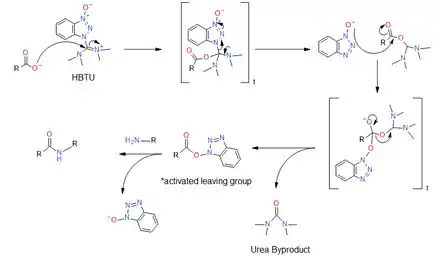HBTU
HBTU (2-(1H-benzotriazol-1-yl)-1,1,3,3-tetramethyluronium hexafluorophosphate, Hexafluorophosphate Benzotriazole Tetramethyl Uronium) is a coupling reagent used in solid phase peptide synthesis. It was introduced in 1978[1] and shows resistance against racemization.[2] It is used because of its mild activating properties.[3]
 | |
| Names | |
|---|---|
| IUPAC name
3-[Bis(dimethylamino)methyliumyl]-3H-benzotriazol-1-oxide hexafluorophosphate | |
| Other names
HBTU | |
| Identifiers | |
3D model (JSmol) |
|
| ChemSpider | |
| ECHA InfoCard | 100.133.815 |
PubChem CID |
|
| UNII | |
CompTox Dashboard (EPA) |
|
| |
| |
| Properties | |
| C11H16F6N5OP | |
| Molar mass | 379.247 g·mol−1 |
| Appearance | White crystals |
| Melting point | 200 °C (392 °F; 473 K) |
| Hazards | |
| Main hazards | Irritant |
| R-phrases (outdated) | R36/37/38-R42/43 |
| S-phrases (outdated) | S22-S26-S36/37/39 |
Except where otherwise noted, data are given for materials in their standard state (at 25 °C [77 °F], 100 kPa). | |
| Infobox references | |
The product obtained by reaction of HOBt with tetramethyl chloro uronium salt (TMUCl) was assigned to a uronium type structure, presumably by analogy with the corresponding phosphonium salts, which bear a positive carbon atom instead of the phosphonium residue. Later, it was shown by X-ray analysis that salts crystallize as aminium rather than the corresponding uronium salts [4] .[5]
Mechanism

HBTU activates carboxylic acids by forming a stabilized HOBt (Hydroxybenzotriazole) leaving group. The activated intermediate species attacked by the amine during aminolysis is the HOBt ester.
To create the HOBt ester, the carboxyl group of the acid attacks the imide carbonyl carbon of HBTU. Subsequently, the displaced anionic benzotriazole N-oxide attacks of the acid carbonyl, giving the tetramethyl urea byproduct and the activated ester. Aminolysis displaces the benzotriazole N-oxide to form the desired amide. [6]
References
- Dourtoglou, Vassilis. (April 1978). "L'hexafluorophosphate de O-benzotriazolyl-N,N-tetramethyluronium: Un reactif de couplage peptidique nouveau et efficace". Tetrahedron Letters. 19 (15): 1269–1272. doi:10.1016/0040-4039(78)80103-8.
- Knorr, R.; Trzeciak, A.; Bannwarth, W.; Gillessen, D. (1989). "New coupling reagents in peptide chemistry". Tetrahedron Letters. 30 (15): 1927–1930. doi:10.1016/S0040-4039(00)99616-3.
- Solange, A. (1992). "HBTU: a mild activating agent of muramic acid". Bioorganic & Medicinal Chemistry Letters. 2 (6): 571–574. doi:10.1016/S0960-894X(01)81199-9.
- Carpino, L.; Imazumi, H.; El-Faham, A.; Ferrer, F.; Zhang, C.; Lee, Y.; Foxman, B.; Henklein, P.; Hanay, C.; Mügge, C.; Wenschuh, H.; Klose, J.; Beyermann, M.; Bienert, M. (2002). "The uronium/guanidinium peptide coupling reagents: Finally the true uronium salts". Angewandte Chemie International Edition. 41 (3): 441–445. doi:10.1002/1521-3773(20020201)41:3<441::AID-ANIE441>3.0.CO;2-N. PMID 12491372.
- Abdelmoty, I.; Albericio, F.; Carpino, L.; Foxman, B.; Kates, S. (1994). "Structural studies of reagents for peptide bond formation: Crystal and molecular structures of HBTU and HATU". Letters in Peptide Science. 1 (2): 57–67. doi:10.1007/BF00126274. S2CID 38746650.
- Bradley, Mark; Valeur, Eric (2009-01-26). "Amide bond formation: beyond the myth of coupling reagents". Chemical Society Reviews. 38 (2): 606–631. doi:10.1039/B701677H. ISSN 1460-4744. PMID 19169468.